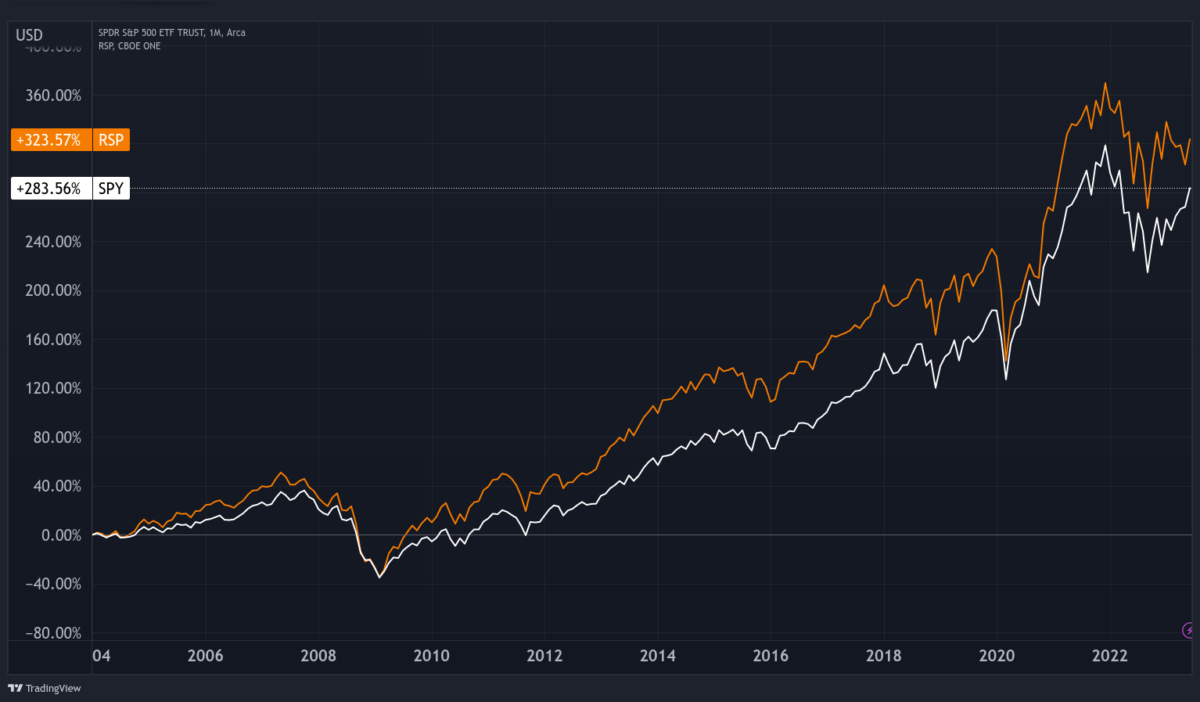Why Invest In Equal-Weighted Indexes?

Most indexes and portfolios weight their holdings by market capitalisation. The largest companies are given a greater share of the available funds due to their importance and relevance. The S&P 500, the Nasdaq 100, the FTSE 100 are just some of the many examples of value-weighted indexes. Passive investing, in the form of ETFs, relies on these indexes and therefore assumes a value-weighted format most of the time. However, research over the past 10 to 15 years has shown that this is not the best strategy. Equal-weighting beats value-weighting almost always and outperforms many alternative strategies.
After selecting a list of stocks to make up a portfolio, an investor needs to choose the best proportions among them. The easiest and most popular option is to use the current market capitalisation as a weighting metric. Another option would be to use the current price. Value weighting lies at the roots of the CAPM and the efficient market hypothesis and has been the top selection metric among investors and academics. However, in recent years, the effectiveness of portfolios based on traditional methods has been questioned, resulting in the emergence of smart beta strategies that rely on alternative factors. Particularly, over the last 15 years, academic research consistently showed the outperformance of equal-weighted strategies over value-weighted ones. The evidence is strong and corroborated across several studies.
One good reason for an equal-weighted (EW) strategy to outperform its value-weighted (VW) alternative is the exposure to the size factor. The weight given to smaller stocks is higher on the EW strategy. Since smaller-cap stocks have a higher risk level in comparison to large-cap stocks, it’s highly expected that EW would outperform VW since there’s a positive correlation between risk and expected returns. From the perspective of an investor, what matters the most is to evaluate whether the extra returns outpace the extra risk. In risk-adjusted terms, do EW strategies outperform VW strategies?
One way of comparing the performance of both strategies on a risk-adjusted basis is by using the Sharpe ratio. Recent studies covering stocks over a very long horizon show that the Sharpe ratio for EW portfolios has been greater than for VW portfolios. Still, investors may be concerned about the risk of EW strategies during specific economic conditions like a recession or financial crisis. But, even when considering these specific sub-periods, the EW is the best strategy almost always. This includes the dot-com bubble of 1999-2001 and the credit crunch of 2007-2008. Where there was underperformance of the EW strategy was during the post credit crisis of 2009-2014, but by just a small margin. These results remind me of those regarding stocks and bonds. Stocks (like EW strategies) outperform bonds (VW strategies) for almost every interval, even though performance sometimes reverts for shorter time periods. From the perspective of a long-term investor, bonds and VW strategies are never a good option.
What Are The Sources Of Outperformance?
Some of you may be curious about what drives outperformance for the EW strategy. In fact, it’s mainly about rebalancing. The higher systematic return of the EW strategy comes from its higher exposure to common risk factors like the market, size and value. In other words, an EW portfolio or index usually carries higher betas. The market beta is higher than one and the size and value betas are positive (greater than zero). But there is an extra part not explained by systematic factors. EW generates a significantly positive alpha. The higher alpha comes from the rebalancing feature associated with the strategy. The gain in performance from rebalancing outpaces its transaction costs, even if rebalance occurs every month. In fact, a monthly rebalance delivers higher alphas than a quarterly or lower periodicity rebalance. Alpha is driven by the contrarian nature of the rebalance strategy, that exploits reversal of stock returns. The EW portfolio reduces its exposure to top performers and increases to bottom performers, on every rebalance. The exposure of an EW portfolio to the momentum factor is negative.
Where To Invest
If you want to invest in the broader market, you may wish to reconsider the assets you purchase. Investing in the Invesco S&P 500 Equal Weight ETF (NYSEARCA:RSP) provides a more efficient and balanced market exposure compared to the SPDR S&P 500 ETF Trust (NYSEARCA:SPY). Both funds invest in the S&P 500 index, but the first rebalances its holdings quarterly. The management fees involved in the Invesco ETF are 0.20%, which are twice as much as those involved in SPY but the outperformance of RSP over the years more than compensates it.

There are several EW portfolio options for indexes different from the S&P 500. For example, you have ETFs targeting the Nasdaq and specific sectors. However, a word of caution goes here. When you invest in a broad market portfolio, the EW strategy allows for a rebalance of stocks and sectors. When you invest in a specific sector, you only gain from stock rebalance but not from sector rebalance. For example, at this point the tech sector is outpacing the broad market. A full EW strategy would reduce exposure to tech, but if you’re investing in an EW Nasdaq 100 portfolio, you won’t get that.
One last point must be made about risk. Small-caps often carry more systematic risk because of their higher betas. However, there is another kind of risk in a portfolio that can be eliminated, which is unsystematic risk. This risk is related to each individual stock and is reduced when we carry many different stocks. In a WW portfolio, it’s often the case there’s a concentration around a few stocks because of their market capitalisation. In this sense, an EW portfolio is much better at reducing unsystematic risk.
Comments (0)